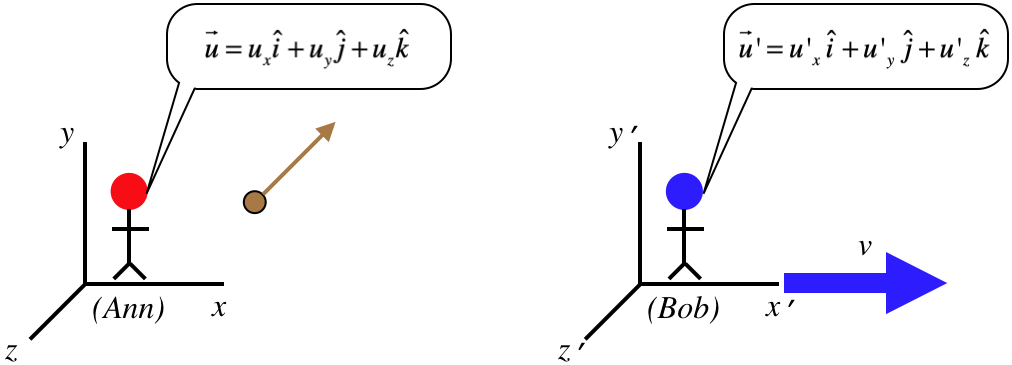2.3: Velocity Addition
( \newcommand{\kernel}{\mathrm{null}\,}\)
Cosmic Speed Limit
We have already said a few times that nothing we have found makes any sense if ordinary objects can move at or beyond the speed of light. So doesn't the whole theory come crashing down in the following scenario?
Bob is moving past Ann at 0.6c in the +x-direction, as she fires off her powerful potato gun in the −x-direction. Ann measures the speed of the potato in her frame to be 0.8c. Bob now measures the speed of the potato – doesn't he see it moving at 1.4c, ruining this whole crazy theory?
This sensible result comes straight from the equally-sensible (and yet wrong) Galilean transformation. Let's consider a case where both Ann and Bob are looking at the same object that is moving relative to both of them (as always, they are moving with a relative speed of v along the x-axis):
Figure 2.3.1 – Ann and Bob Watch the Same Ball

If we use the Galilean transformation to determine how these velocities →u and →u′ relate to each other, we get:
t′=t⇒dt′dt=1x′=x−vt⇒u′x=dx′dt′=dx′dtdtdt′=(dxdt−v)(1)=ux−vy′=y⇒u′y=dy′dt′=dy′dtdtdt′=(dydt)(1)=uyz′=z⇒u′z=dz′dt′=dz′dtdtdt′=(dzdt)(1)=uz
So this gives the result we expected before we ever heard of relativity. But now we know that the Galilean transformations are just an approximation of what really describes our universe, and that we actually need to use the lorentz transformation equations instead. So let's follow precisely the method we followed above with the lorentz transformation to find how velocities add in relativity. [Note that we have to use the γ that goes with the relative velocity of the two frames (since that is what transforms the coordinates), not the gamma related to the relative motion of the ball. This velocity is not changing, so γv is treated as a constant in the derivatives to come.]
ct′=γv[ct−(vc)x]⇒dt′dt=γv[1−(vc2)dxdt]=γv(1−uxvc2)x′=γv(x−vt)⇒u′x=dx′dt′=dx′dtdtdt′=γv(dxdt−v)[γv(1−uxvc2)]−1=ux−v1−uxvc2y′=y⇒u′y=dy′dt′=dy′dtdtdt′=(dydt)[γv(1−uxvc2)]−1=uyγv(1−uxvc2)z′=z⇒u′z=dz′dt′=dz′dtdtdt′=(dzdt)[γv(1−uxvc2)]−1=uzγv(1−uxvc2)
Note that the signs of the components of →u are important here. When ux>0, the x-component of the ball's velocity measured in Ann's frame is in the same direction as Bob is moving relative to Ann, and Bob sees the velocity of the ball as a little bit faster than the Galilean transformation predicts, because the denominator of the velocity transformation is less than 1. On the other hand, if the ball's velocity has an x-component in Ann's frame that is opposite to Bob's direction of motion (ux<0), then the velocities add, but the sum is not as great as is predicted by the Galilean transformation, because the denominator is greater than 1.
So let's try the example that started this discussion. Putting in the velocity of the potato in Ann's frame and Bob's relative velcoity with Ann gives the speed measured by Bob:
u′x=ux−v1−uxvc2=−0.8c−0.6c1−(−0.8c)(0.6c)c2=−1.4c1+0.48=−0.946c
The cosmic speed limit is obeyed!
Example 2.3.1
Here's another idea to bring relativity to its knees: Maybe we can't get a speed greater than c for a moving object by stacking one velocity on top of another because neither of them can be going a speed c to begin with, but what if Ann shines a light so that the light's speed adds to Bob's speed? Won't Bob measure the light going faster than c?
- Solution
-
Well, this clearly violates the postulate of relativity, but let's use this idea to check our velocity formula anyway. Putting ux=±c into the velocity transformation indeed gives us the right answer:
u′x=±c−v1−(±c)(v)c2=±c
Velocity Vectors
We have focused on the effects of velocity addition along the direction of motion, but perhaps a result we didn't see coming was that relative motion along the x-direction also affects the relationship between the two observers' measurements of velocities in directions perpendicular to the relative motion. This comes about because of the time dilation effect – if time is passing more slowly in another frame than in your own, then things are moving more slowly in those perpendicular directions. For example, if Bob sees time passing more slowly for Ann as she moves by, then when she drops her pencil, it will take longer to get to the floor from Bob's perspective than from Ann's perspective, so for Bob the pencil is moving more slowly, even though it is moving in a direction perpendicular to the relative motion.
Suppose as Bob zooms by, Ann fires a laser in the +y direction. What does Bob see for the laser's speed and direction? Well, he had better see a speed of c, and thanks to the velocity transformation, he does:
ux=0⇒u′x=0−v1−0=−vuy=c⇒u′y=cγv(1−0)=√c2−v2}|→u′|=√u′2x+u′2y=c
Bob and Ann don't agree on the direction however. While Ann sees the laser going in the +y direction, Bob sees an angle with his y′-axis:
sinθ=vc⇒θ=sin−1(vc)


